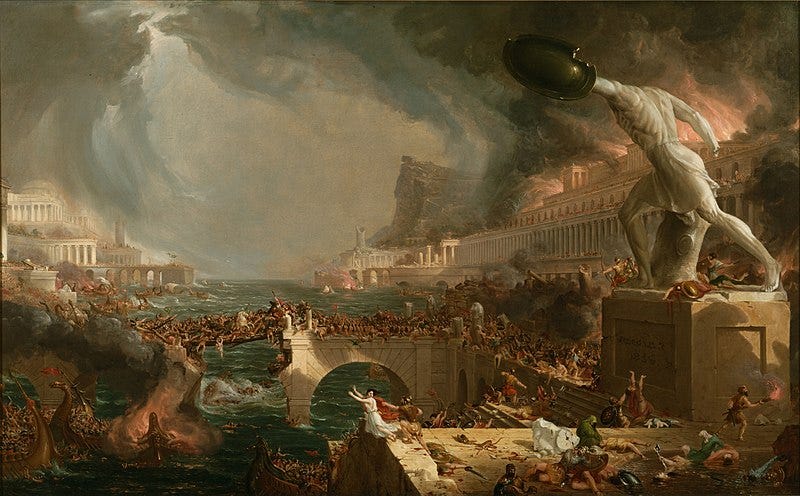Rome must be destroyed!
In 546 AD, faced with a completely uninhabited Rome, Totilas, king of the Ostrogoths, gave the order to destroy the city.
Probably the most famous sackings in the history of the city of Rome are those that occurred in the 5th century, in the context of the fall of the western part of the Roman Empire. First the Visigoths under Alaric in 410 AD, then Genseric under the Vandals in 455, and finally in 472 at the hands of the army of Ricimer. On none of these occasions did the city come so close to being razed to the ground and disappear as when Totilas gave the order in 546, after his troops had seized the city, which had previously been reconquered by the Roman Empire.
Puedes leer este artículo en español haciendo click aquí.

In 146 BC when Scipio Aemilianus, conqueror of Carthage, transmitted the Roman Senate's order to destroy the Punic city, he cried and recited the following verses from the Iliad:
There will come a day when sacred Ilion will have perished, and Priam, and Priam's people, the optimal spearman.
When the historian Polybius, who had accompanied him in the campaign against Carthage as an adviser and friend, asked him what he meant by these verses, the Roman general confessed that he feared for the fate of Rome and the day when another would give the same order against his city (Polybius, Histories, 38. 21-22).
Scipio Aemilianus was overwhelmed. In the Greco-Roman worldview, time and processes were cyclical, so that all that achieved greatness had to fall in its own time. Now it was the turn of Carthage at the hands of the Romans, who were imposing themselves as the new masters of the Mediterranean. Eventually, it would be their turn to enter the age of decadence and eventual destruction that empires live and die by. Scipio Aemilianus, well aware of what his eyes were seeing, was very clear that no matter how great Rome was at the time, nothing would exclude it from the fate of all great kingdoms and empires: to fall.
Some see the three sackings of Rome in the 5th century AD, especially the sack of 410 by Alaric, as a kind of fulfilment of Scipio Aemilianus' calculations and reflections on the destruction of Carthage. However, although these sackings of Rome, especially in the context of the disintegration of imperial power in the West, had a strong collective impact on all the inhabitants of the Empire, they in no way entailed the destruction of the city, nor the reduction of large parts of its population to a state of slavery. The sackings of Rome were that, sackings in their strict definition, and after these, the city, its institutions and the Roman people continued to exist. Nevertheless, Rome was still Rome. By contrast, in 546, when Totilas gave the order to sack and raze Rome to the ground, the city had been uninhabited for several months, the product of a slow process of deterioration and population decline due to the war between the Roman troops sent from Constantinople to reconquer Italy, and the Ostrogoths, who had established their kingdom in the area at the end of the previous century under Theodoric.
Let's put things in context to understand how the city of Rome came to this point. In 535, after having reconquered Africa for the Roman Empire, Emperor Justinian's ambition was to reconquer Italy and reintegrate the city of Rome into the imperial domains. Italy was in the hands of the Ostrogoths, who had ruled the peninsula since 493 under their king Theodoric, who, at the request of the Roman emperor in Constantinople, Zeno, invaded Italy to drive out the Heruli of Odoacer, the barbarian king who deposed the last emperor of the western part of the Empire.
But when Emperor Justinian came to power in Constantinople, he made other plans for Italy: like the former provinces of Africa and Hispania, they were to be brought back under the direct rule of the Roman Empire. In 534 the general Belisarius reconquered Africa for the Romans, and the following year he sailed to Sicily to declare war on the Ostrogoths for control of Italy, thus beginning the Gothic War (AD 535-554).
In 536, Belisarius crossed to Italy and captured Neapolis, then advanced northwards towards Rome, where the senate and its inhabitants decided to open the gates to the Roman army. This caused them to be besieged for about a year by the Ostrogoths under the command of their king Vitigis, who took as one of his first measures the destruction of the fourteen aqueducts that supplied water to the city. According to the historian Procopius, who accompanied Belisarius to Italy as his personal secretary, after six months of siege the Roman general ordered all the women and children to leave the city and seek refuge in Neapolis, as food supplies were becoming increasingly scarce (Goth. 5. 25. 2). Even so, the Ostrogoths' efforts to take the city did not bear fruit. Their king Vitigis, driven by anger and frustration, ordered the execution of most of the Roman senators, whom he had taken hostage at the beginning of the war (Goth. 5. 26. 1). This was the first great disaster for the people of Rome.
A year into the siege, when new enemy reinforcements arrived, the Ostrogoths decided to withdraw and regroup at Ravenna. The theatre of war shifted to northern Italy, and in 540, Vitigis asked Belisarius for peace and was sent as a prisoner to Constantinople. But some Goths opposed this and proclaimed Totilas as their new king to continue the war against the Romans.
In the tenth year of the war, under the command of Totilas, the Ostrogoths laid siege to Rome for the second time. During this, the Roman generals in charge of the city –Belisarius was not among them– allowed the remaining population to leave Rome so that they would not have to endure the siege. Procopius recounts that only about five hundred Romans remained in the city, and that the rest perished from starvation or at the hands of Ostrogothic troops as they moved into southern Italy (Goth. 7. 17. 23-25). Eventually, Totilas captured Rome in 546 and his troops sacked the city, which was virtually empty as the Roman army was able to retreat at the same time as the Ostrogoths entered.
To prevent the city from becoming a Roman stronghold again, and also to punish its population (or what was left of it), which at the beginning of the war had gone over to the Roman side, Totilas decided to raze Rome to the ground. The Ostrogoths began the works, demolishing part of the walls and some of the peripheral buildings. It was a letter from Belisarius, begging Totilas to stop to avoid a crime against humanity, that saved what was left of Rome (Procop. Goth. 7. 22. 8-16). The Ostrogoths withdrew in 547 and Belisarius and his army prepared to occupy the city, where he left a garrison before marching north. In 549 Totilas advanced with an army to besiege Rome again. The following year he recaptured it and decided to repopulate it with Roman prisoners and Ostrogothic settlers (Procop. Goth. 7. 37. 2-3).
Totilas died in 552 when he was wounded in the battle of Tangina, where the Ostrogoths were defeated by the Roman army under Narses, who after his victory marched towards Rome to recapture it once again for the Empire. This led to the fourth siege of Rome in the war. The few surviving Romans who were still prisoners of the Ostrogoths were executed on the orders of their new king, Teyas. That was the end of the Romans' misfortunes in the war, for shortly thereafter, in 554, the Ostrogoths asked for peace and Emperor Justinian agreed on the condition that they leave Italy, which was reintegrated into the Roman Empire.
In the course of the Gothic War Rome suffered four sieges, was uninhabited between 546 and 547, part of its walls, buildings and aqueducts were demolished, and most of its population was exterminated or relocated in Campania and Sicily. This war was a much more destructive process for Italy and Rome in particular, than what had happened in the previous century with the disintegration of imperial power in the area. If Scipio Aemilianus was right with his prediction, it seems to me that it is with the sack of Rome in 546 at the hands of the Ostrogoths. Only Belisarius' letter to Totilas, appealing to the glorious past of the city and the affront it would mean against all mankind to raze it to the ground, allowed Rome to continue to exist so that we can appreciate and enjoy it in all its majesty and glory today, almost fifteen hundred years later.
If you are not a subscriber and you are interested in my content, I invite you to do so - you will support my work and motivate me to keep writing!
If you like what you read, you can start a paid subscription as a donation as all my content is free, whether it's one month or many, your contribution will mean a lot to keep me writing!



This is a fascinating history to be sure. Many Italians appear to still hold a grudge against Justinian based on some conversations I had last year in Ravenna. The Roman army was too small for the invasion, leading to a destructive and drawn out war when compared to the reconnect of Africa.
Great piece. Thank you.